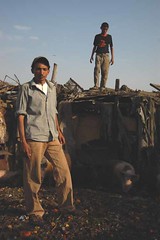
Tuesday 31 July 2007
Spider Pig!
After watching The Simpsons Movie, I was at first disappointed that we didn't get to know what happened to Homer's new friend Spider Pig, or Harry Plopper. I assumed he had perished, like a sinful seducer who finds redemption in the last minute and can die and go to heaven, after all ... But then I read that he will make an appearance in the first episode of the new Simpsons season, which changed the symbolism of his role a bit.


Monday 9 July 2007
Scythian boar imagery
 Today I was at the recently opened exhibition "Under the Sign of the Golden Griffin - The Royal Tombs of the Scythians" in the Martin-Gropius-Bau. I somehow imagined that photographing would not be permitted, so there I was with my drawing pad while everyone else was taking tons of pictures of the exhibits with their digicams and phones. Oh well, maybe I'll go there another time with my camera.
Today I was at the recently opened exhibition "Under the Sign of the Golden Griffin - The Royal Tombs of the Scythians" in the Martin-Gropius-Bau. I somehow imagined that photographing would not be permitted, so there I was with my drawing pad while everyone else was taking tons of pictures of the exhibits with their digicams and phones. Oh well, maybe I'll go there another time with my camera. Most of the exhibits were extremely elaborate metal works that had been well preserved in graves and other sites. A lot of the designs had animal motifs: most commonly horses, which were essential in the Scythian lifestyle, and deer, which probably were the most common and/or popular prey of Scythian hunters, but there were also motifs of other animals, like moose, tigers, fish, wolves, eagles, roosters, etc., depending a bit on the fauna of the region of their origin. Of course, I kept an eye out for images of boars.
Most of the exhibits were extremely elaborate metal works that had been well preserved in graves and other sites. A lot of the designs had animal motifs: most commonly horses, which were essential in the Scythian lifestyle, and deer, which probably were the most common and/or popular prey of Scythian hunters, but there were also motifs of other animals, like moose, tigers, fish, wolves, eagles, roosters, etc., depending a bit on the fauna of the region of their origin. Of course, I kept an eye out for images of boars.The two first sketches are adornments on horse bridles, two boars among dozens of deer, ibex, moose, tigers and other animals, from the 5th century BCE.
 Though images of deer and horses clearly dominated, there were also a few boars. Most of them were depicted in hunting scenes or perhaps as food offerings, often along with deer.
Though images of deer and horses clearly dominated, there were also a few boars. Most of them were depicted in hunting scenes or perhaps as food offerings, often along with deer.The two boars on the left are from a petroglyph from the kurgan in Arzhan, Tuva. They are part of a design with three boars and four ibex sheep. The boars below are from another petroglyph at the same site. Towards the left, the design continues with deer figures. The boars in this images appear to be lying down on their side, and are thus most likely depictions of offerings.

This golden pectoral found in Ordzhonikidze was also among the exhibits. Its design incorporates various scenes, among them a lion attacking a wild boar.
Here is a photo with some of the golden adornments worn by a noble couple found in a grave in Arzhan. Among them are "thousands of little panthers and boars from the cloaks of the couple".

Above to the left is a sketch of one of several dozens of little golden boar figures that used to adorn a quiver (Arzhan, Tuva, late 7th century BCE). The sketch on the right might give an impression of how the little boars were arranged. (Each dimple = a little golden boar figure).
Maybe they were supposed to give good luck in hunting, or be symbols for all the boars that the owner of the quiver had slain.
 On the left is a dagger with a knob in the shape of a boar from Arzhan, Tuva. There was only a schematic drawing of it in the exhibition.
On the left is a dagger with a knob in the shape of a boar from Arzhan, Tuva. There was only a schematic drawing of it in the exhibition.There were also boar's teeth on display (9th-8th century BCE), which had been worn as a necklace, perhaps as hunting trophies.
In excavations of ancient fortifications in Stânceşti, Moldova, something quite interesting had been found: a fish with the head of a boar and, probably, the tail of a bird. It stems from the 5th or 4th century BCE, and was most likely part of a headdress for a horse, worn on the side of the horse's face. It was about 30 cm long and made of gold.

One interpretation is that the figure symbolizes the three elements earth (boar), water (fish) and air (bird). "Similar motifs have been found among both Thrakian an Scythian remains", it said.
The scythian noblemen had fiercely kick-ass tattoos, but unfortunately none of the tattoos shown in this exhibition (in drawings, a mummified man and the preserved skin from another man's arm) had any boar motifs.
Subscribe to:
Posts (Atom)




